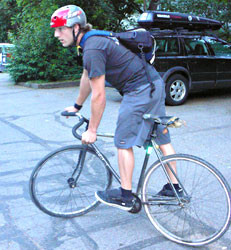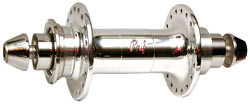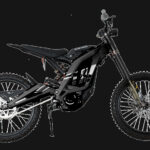Fixed gear bikes, often called “fixies,” represent a unique and stylish approach to urban cycling. If you’re intrigued by their minimalist design and the direct connection they offer to the road, you’re in the right place. This guide dives deep into the world of fixed gear bikes, helping you understand what makes them special and why they might be the Best Fixed Gear Bikes for your needs.
 Fixies are a sweet and stylish way to get around town!
Fixies are a sweet and stylish way to get around town!
Alt text: Stylish cyclist performs a track stand on a vibrant fixed gear bike in an urban setting, showcasing the agility and control fixies offer.
What Exactly is a Fixed Gear Bike?
The term “fixie” is short for “fixed gear,” and it refers to a bicycle drivetrain where the single gear is directly bolted to the rear wheel. This fixed connection means there’s no freewheel mechanism; you cannot coast. As long as the bike is moving, your pedals are turning. This fundamental difference sets fixies apart from other types of bikes and contributes to their distinctive riding experience.
Unlike bikes with multiple gears and complex shifting systems, fixed gear bikes are remarkably simple. They typically lack derailleurs, shifters, and sometimes even brakes (though for safety and legality, brakes are highly recommended and often required). This simplicity isn’t a limitation; it’s a core part of the fixie’s appeal.
While road-style fixies are the most common, the fixed gear concept extends to other cycling disciplines. Some riders even explore the trails with mountain bike fixies, demonstrating the versatility of this unique drivetrain. It’s important not to confuse fixies with single-speed bikes, which, despite having only one gear, do allow coasting.
The Allure of Fixed Gear Riding
Fixed gear bikes have cultivated a dedicated following for several compelling reasons:
- Fun and Engagement: Riding a fixie is an incredibly engaging experience. The direct drive creates a unique connection between you and the bike. You become intimately aware of your cadence, momentum, and the terrain beneath you. This direct feedback loop is exhilarating and can transform your daily commute into a more mindful and enjoyable activity.
- Stylish Simplicity: Fixies are visually striking. Their clean lines, often bold colors, and minimalist aesthetic make them stand out. Riders often personalize their fixies with custom paint jobs, unique components, and accessories, turning them into rolling expressions of individual style.
- Low Maintenance: With fewer parts than geared bikes, fixies require significantly less maintenance. No derailleurs to adjust, no shifters to break – the simplicity of the drivetrain translates to less time in the workshop and more time on the road. This makes them a practical choice for urban riders seeking a reliable and low-fuss mode of transportation.
You’ve likely seen fixie riders zipping through city streets, their bikes a flash of color against the urban backdrop. Their distinct look and riding style often spark curiosity. Why are these bikes so popular? How can people navigate busy streets with just one gear and no coasting? The answers lie in the unique experience and benefits that fixed gear bikes offer.
***](http:///)
Alt text: A stylish female cyclist confidently rides a brightly colored fixed gear bike, embodying the trendy and individualistic culture associated with fixie riding.*
The Smooth, Connected Fixie Feeling
Riding a fixed gear bike provides a sensation unlike any other. It’s a feeling of direct connection and efficiency that harkens back to the early days of cycling. Because your legs are constantly engaged with the rear wheel, your pedal stroke becomes more refined and efficient. The absence of a freewheel eliminates “dead spots” in your pedal stroke, maximizing power transfer.
Fixed gear riding also encourages a higher cadence, or pedal rate. You learn to spin smoothly and efficiently because you must pedal continuously, even downhill. This constant motion builds leg speed and endurance. Furthermore, without the option to shift gears, your mental energy is freed from gear selection, allowing you to focus more on your surroundings and the pure act of cycling.
The connection between rider and machine becomes almost symbiotic. Skilled riders can develop incredible bike control, even balancing in place or slowing down without traditional brakes, simply by resisting the pedal rotation. This level of bike-body integration is a hallmark of fixed gear riding.
The fixed gear culture itself is often associated with a sense of individuality and counter-culture. However, the joy of riding a fixie is universal. You don’t need to fit a particular stereotype to appreciate the unique ride and the engaging simplicity of these bikes.
Track vs. Road Fixies: Understanding the Difference
While the terms “fixed gear bike” and “track bike” are sometimes used interchangeably, they are not the same. Track bikes are specifically designed for velodromes – indoor and outdoor banked oval tracks used for competitive cycling.
Track bikes are purpose-built for racing on smooth, predictable surfaces. They are characterized by:
- No Brakes: Track bikes typically lack brakes. On the velodrome, braking is unnecessary and even dangerous due to the consistent direction of travel and controlled environment.
- Stiff Frames: Track bike frames are exceptionally stiff for maximum power transfer and efficiency in high-speed racing.
- Aggressive Geometry: Track bike geometry is optimized for sharp handling and responsiveness at race speeds.
While some fixed gear enthusiasts, particularly those with a track cycling background, may ride track bikes on the street, they are generally not ideal for everyday urban riding. Track bikes can be unforgivingly stiff, and their ultra-responsive handling demands constant attention, making them less comfortable and practical for typical street conditions.
For most riders seeking the best fixed gear bikes for urban environments, a road-oriented fixie is a better choice. These bikes are designed with street riding in mind, offering a more comfortable geometry and sometimes incorporating features like brake mounts and wider tire clearance for versatility. Many manufacturers offer complete fixies specifically designed for the road, and it’s also possible to convert a standard road bike into a fixie.
Choosing the Right Gear Ratio: Finding Your Sweet Spot
Since fixies have only one gear, selecting the optimal gear ratio is crucial. The “right” gear depends on several factors:
- Riding Style (Cadence): Do you prefer to pedal quickly (high cadence) or with more force at a slower pace (lower cadence)?
- Terrain: Will you be riding primarily on flat roads, rolling hills, or steeper climbs?
- Fitness Level: Stronger riders can handle higher (harder) gears, while less experienced riders may prefer easier gears.
A general guideline is that you can often ride a slightly harder gear on a fixie compared to a freewheel bike, thanks to the constant momentum provided by the fixed gear. The ideal gear should be easy enough to tackle hills comfortably but not so easy that you lose control when descending.
When purchasing a new fixie, knowledgeable bike shop staff can assist you in choosing an appropriate gear ratio based on your riding style and local terrain. Test riding the bike is essential to ensure the gearing feels right for you.
Hubs, Chains, and Frames: Essential Fixie Components
 The Phil Wood fixed-gear hub is bicycle jewelry!
The Phil Wood fixed-gear hub is bicycle jewelry!
Alt text: A close-up shot highlighting the polished and intricately designed Phil Wood fixed gear hub, emphasizing the quality and craftsmanship of high-end fixie components.
-
Rear Hub: The rear hub is a critical component unique to fixed gear bikes. It features opposing sets of threads on the right side. One set is for the fixed cog, and the other is for a lockring that tightens against the cog, preventing it from unscrewing due to backpedaling forces. Some hubs also have threads on the left side, allowing for a different sized cog or a freewheel to be installed, offering gear or riding style versatility. Fixie hubs often utilize threaded axles and axle nuts instead of quick releases to securely hold the wheel in place within horizontal dropouts, which are essential for chain tension adjustment.
-
Chain: Bicycle chains come in different widths, primarily 1/8 inch and 3/32 inch. Track fixies often use the wider, heavier 1/8-inch chain, known for its durability (also common on BMX and classic roadster bikes). However, 3/32-inch chains are more frequently used on road fixies as they are compatible with standard road and mountain bike chainrings and are generally more flexible, lighter, and quieter. If converting an older road bike to a fixie, using a 3/32-inch chain allows you to retain the original crankset.
-
Frame: For converting a bike to fixed gear, a frame with horizontal dropouts is essential. These adjustable dropouts allow for chain tensioning. Older steel road bike frames from the 1980s and 90s often feature horizontal dropouts and are excellent candidates for fixie conversions. These frames are typically constructed from high-quality steel, offering a comfortable ride and classic aesthetics. When considering a frame for a fixie project, check your garage or local listings for older steel road bikes – they might be the perfect starting point.
Customizing Your Fixie: Express Your Style
One of the most appealing aspects of fixie culture is the opportunity for personalization. Fixies are blank canvases for self-expression. Beyond basic customization like stickers and bells, fixie riders often go much further:
- Component Swaps: Experiment with flat bars, motorcycle grips, deep-dish rims, color-matched hubs, and even vintage components like cottered cranks, leather saddles, and quill stems to create a truly unique machine.
- Paint Jobs: A custom paint job is a classic way to make your fixie stand out. From bold colors to intricate designs, your frame can become a reflection of your personal style.
Let your imagination guide your fixie project. There are no limits to how you can customize your ride and make it unmistakably yours.
Conclusion: Embrace the Fixed Gear Experience
Fixed gear bikes offer a unique and compelling cycling experience. Their simplicity, engaging ride quality, and potential for personalization have made them a favorite among urban cyclists and cycling enthusiasts alike. Whether you’re seeking a stylish and low-maintenance commuter, a fun and engaging way to stay fit, or a platform for self-expression, exploring the world of best fixed gear bikes is a worthwhile journey.
We encourage you to explore our selection of fixed gear bicycles and discover the perfect fixie to match your style and riding needs. Our experts are here to answer your questions and help you with all your fixed gear projects. Embrace the fixie feeling and experience the pure joy of cycling in its most direct and engaging form.

